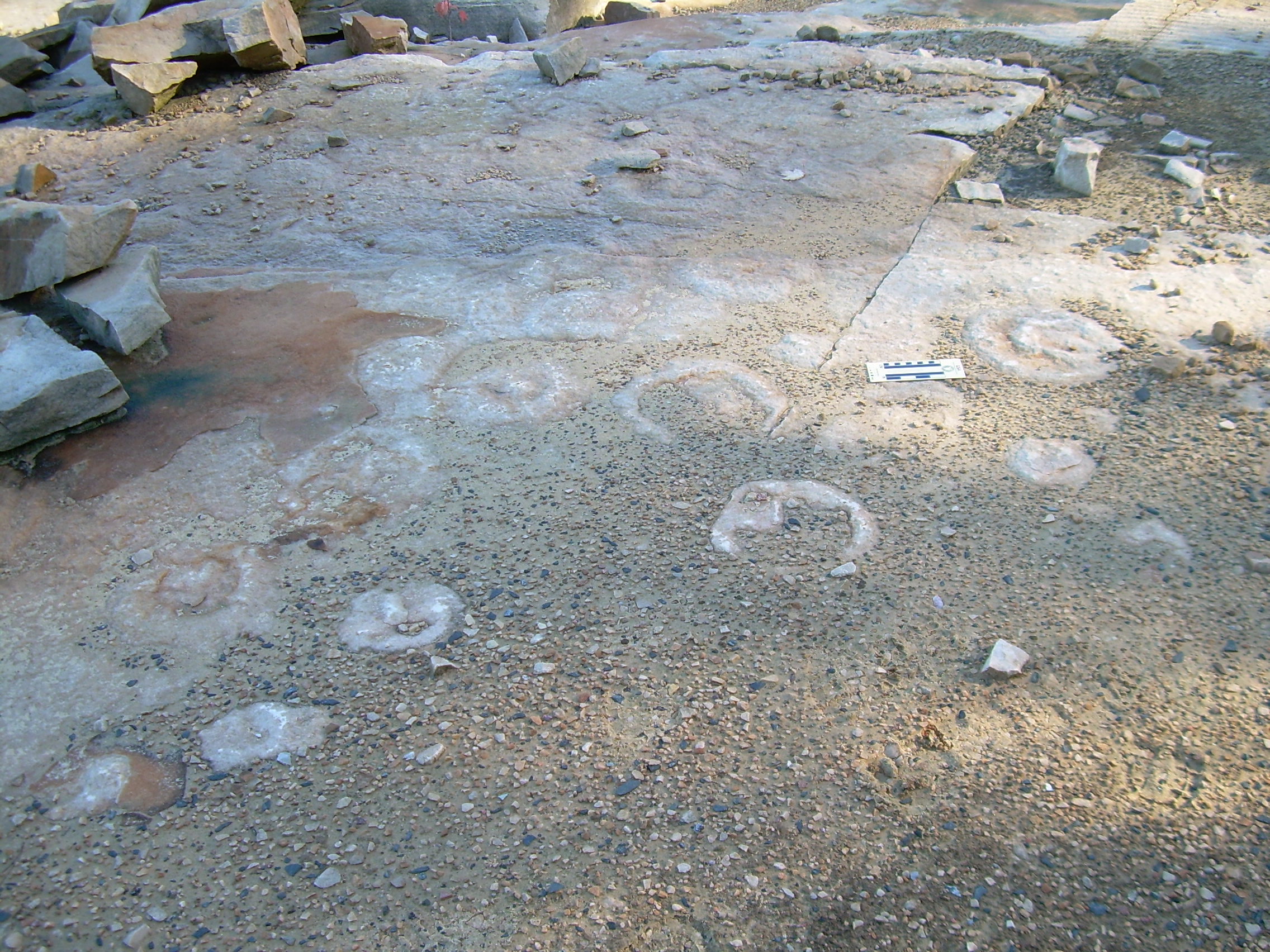|
Scyphozoa
The Scyphozoa are an exclusively marine class of the phylum Cnidaria, referred to as the true jellyfish (or "true jellies"). The class name Scyphozoa comes from the Greek word '' skyphos'' (), denoting a kind of drinking cup and alluding to the cup shape of the organism. Scyphozoans have existed from the earliest Cambrian to the present. Biology Most species of Scyphozoa have two life-history phases, including the planktonic medusa or polyp form, which is most evident in the warm summer months, and an inconspicuous, but longer-lived, bottom-dwelling polyp, which seasonally gives rise to new medusae. Most of the large, often colorful, and conspicuous jellyfish found in coastal waters throughout the world are Scyphozoa. They typically range from in diameter, but the largest species, '' Cyanea capillata'' can reach across. Scyphomedusae are found throughout the world's oceans, from the surface to great depths; no Scyphozoa occur in freshwater (or on land). As medusae, they eat ... [...More Info...] [...Related Items...] OR: [Wikipedia] [Google] [Baidu] |
Cnidaria
Cnidaria () is a phylum under kingdom Animalia containing over 11,000 species of aquatic animals found both in Fresh water, freshwater and Marine habitats, marine environments, predominantly the latter. Their distinguishing feature is cnidocytes, specialized cells that they use mainly for capturing prey. Their bodies consist of mesoglea, a non-living jelly-like substance, sandwiched between two layers of epithelium that are mostly one cell (biology), cell thick. Cnidarians mostly have two basic body forms: swimming Medusa (biology), medusae and Sessility (motility), sessile polyp (zoology), polyps, both of which are Symmetry (biology)#Radial symmetry, radially symmetrical with mouths surrounded by tentacles that bear cnidocytes. Both forms have a single Body orifice, orifice and body cavity that are used for digestion and respiration (physiology), respiration. Many cnidarian species produce Colony (biology), colonies that are single organisms composed of medusa-like or polyp (z ... [...More Info...] [...Related Items...] OR: [Wikipedia] [Google] [Baidu] |
Medusa (biology)
Jellyfish and sea jellies are the informal common names given to the medusa-phase of certain gelatinous members of the subphylum Medusozoa, a major part of the phylum Cnidaria. Jellyfish are mainly free-swimming marine animals with umbrella-shaped bells and trailing tentacles, although a few are anchored to the seabed by stalks rather than being mobile. The bell can pulsate to provide propulsion for highly efficient locomotion. The tentacles are armed with stinging cells and may be used to capture prey and defend against predators. Jellyfish have a complex life cycle; the medusa is normally the sexual phase, which produces planula larvae that disperse widely and enter a sedentary polyp phase before reaching sexual maturity. Jellyfish are found all over the world, from surface waters to the deep sea. Scyphozoans (the "true jellyfish") are exclusively marine, but some hydrozoans with a similar appearance live in freshwater. Large, often colorful, jellyfish are common in c ... [...More Info...] [...Related Items...] OR: [Wikipedia] [Google] [Baidu] |
Jellyfish
Jellyfish and sea jellies are the informal common names given to the medusa-phase of certain gelatinous members of the subphylum Medusozoa, a major part of the phylum Cnidaria. Jellyfish are mainly free-swimming marine animals with umbrella-shaped bells and trailing tentacles, although a few are anchored to the seabed by stalks rather than being mobile. The bell can pulsate to provide propulsion for highly efficient animal locomotion, locomotion. The tentacles are armed with Cnidocyte, stinging cells and may be used to capture prey and defend against predators. Jellyfish have a complex Biological life cycle, life cycle; the medusa is normally the sexual phase, which produces planula larvae that disperse widely and enter a sedentary polyp (zoology), polyp phase before reaching sexual maturity. Jellyfish are found all over the world, from surface waters to the deep sea. Scyphozoans (the "true jellyfish") are exclusively marine habitats, marine, but some hydrozoans with a simila ... [...More Info...] [...Related Items...] OR: [Wikipedia] [Google] [Baidu] |
Aurelia Aurita
''Aurelia aurita'' (also called the common jellyfish, moon jellyfish, moon jelly or saucer jelly) is a species of the genus '' Aurelia''. All species in the genus are very similar, and it is difficult to identify ''Aurelia'' medusae without genetic sampling; most of what follows applies equally to all species of the genus. The most common method used to identify the species consists of selecting a jellyfish from a harbour using a device, usually a drinking glass and then photographing the subject. This means that they can be released in to the harbour shortly afterwards and return to their natural habitat. The jellyfish is almost entirely translucent, usually about in diameter, and can be recognized by its four horseshoe-shaped gonads, easily seen through the top of the bell. It feeds by collecting medusae, plankton, and mollusks with its tentacles, and bringing them into its body for digestion. It is capable of only limited motion, and drifts with the current, even when swimming ... [...More Info...] [...Related Items...] OR: [Wikipedia] [Google] [Baidu] |
Rhopalia
Rhopalia (singular: rhopalium) are small sensory structures of certain Scyphozoan (true jellyfish) and Cubozoan (box jellyfish) species. Description The structures typically occur in multiples of four, are bell shaped and face outward from invaginations around the bell of the jelly's mantle. They are each connected ectodermally to the periphery of other rhopalia by a stalk-like projections which join extremities in a skirt-like shape. These connections form the junctions of the cnidarian 'central nervous system', which synapse within the rhopalial centers. Rhopalia vary in form, size and number, but ubiquitously consist of specialized structures to sense light (ocelli), which line the structure, and regions to perceive gravity (statoliths) at their terminal tip. Rhopalia are unique to the medusoid forms of Cnidarians and are best studied in Scyphozoa'','' within the genus '' Aurelia,'' which exhibits the most typical arrangement and structure of rhopalia in marginal indentations ... [...More Info...] [...Related Items...] OR: [Wikipedia] [Google] [Baidu] |
Cephea Cephea
''Cephea cephea'', also known as the crown jellyfish, or cauliflower jellyfish, is a species of jellyfish in the family Cepheidae. It occurs in the tropical waters of the western Indo-Pacific to Northern Australia. The species was first described by Peter Forsskål in 1775 and originally given the name ''Medusa cephea''. It inhabits the pelagic zone of tropical and sub-tropical waters and is most commonly found in the Indo-West Pacific, eastern Atlantic and the Red Sea. Although this species is among the most venomous jellyfish, it is not harmful to humans and is eaten as a delicacy and used for medical purposes in China and Japan. The species can achieve a diameter of up to 60 cm. Description ''Cephea cephea'' is purplish-blue in color and grow to up to 60 centimeters in diameter. This species has wart-like projections and a bell shape that is associated with the given common names for the species. As in other jellyfish species, the tentacles contain nematocysts that are ... [...More Info...] [...Related Items...] OR: [Wikipedia] [Google] [Baidu] |
Strobilation
Strobilisation or transverse fission is a form of asexual reproduction consisting of the spontaneous transverse segmentation of the body. It is observed in certain cnidarians and helminths. This mode of reproduction is characterized by high offspring output, which, in the case of the parasitic tapeworms, is of great significance. Strobilation in cnidarians *The process starts with preliminary morphological changes. In particular, the cnidarian's tentacles tend to be reabsorbed. *Neck-formation: transverse constrictions appear near the upper extremity of the animal. A strobilating polyp is called a strobila while the non-strobilating polyp is called a scyphistoma or scyphopolyp. *Segmentation: the number of constriction sites increases and migrates down the body length, transforming the body into a sequence of disks. The fissures intensify until the initial body is divided into equally spaced, separate segments. The oral end of the polyp becomes the oral end of the ephyra. *Metamorp ... [...More Info...] [...Related Items...] OR: [Wikipedia] [Google] [Baidu] |
Planula
A planula is the free-swimming, flattened, ciliated, bilaterally symmetric larval form of various cnidarian species and also in some species of Ctenophores. Some groups of Nemerteans also produce larvae that are very similar to the planula, which are called planuliform larva. Development The planula forms either from the fertilized egg of a medusa, as is the case in scyphozoans and some hydrozoans, or from a polyp, as in the case of anthozoans. Depending on the species, the planula either metamorphoses directly into a free-swimming, miniature version of the mobile adult form, or navigates through the water until it reaches a hard substrate (many may prefer specific substrates) where it anchors and grows into a polyp. The miniature-adult types include many open-ocean scyphozoans. The attaching types include all anthozoans with a planula stage, many coastal scyphozoans, and some hydrozoa Hydrozoa (hydrozoans; ) are a taxonomic class of individually very small, predat ... [...More Info...] [...Related Items...] OR: [Wikipedia] [Google] [Baidu] |
Skyphos
A ''skyphos'' ( grc, σκύφος; plural ''skyphoi'') is a two-handled deep wine-cup on a low flanged base or none. The handles may be horizontal ear-shaped thumbholds that project from the rim (in both Corinthian and Athenian shapes), or they may be loop handles at the rim or that stand away from the lower part of the body. ''Skyphoi'' of the type called '' glaux'' (owl) have one horizontal and one vertical thumbhold handle. Examples Early ''skyphoi'' were made during the Geometric period. Corinth set the conventions that Athens followed. Over a long period the shape remained the same while the style of decoration changed. ''Skyphoi'' were also made of precious metals, generally silver and gold leaf, many examples exist. One possible, well-preserved example is the Warren cup,In his notes, John Pollini states that uncertainty about the correct name of many ancient drinking vessels exists, however he refers to the object with the "established classificatory term scyphus", Spe ... [...More Info...] [...Related Items...] OR: [Wikipedia] [Google] [Baidu] |
Cassiopea
''Cassiopea'' (upside-down jellyfish) is a genus of true jellyfish and the only members of the family Cassiopeidae. They are found in warmer coastal regions around the world, including shallow mangrove swamps, mudflats, canals, and turtle grass flats in Florida, and the Caribbean and Micronesia. The medusa usually lives upside-down on the bottom, which has earned them the common name. These jellyfish partake in a symbiotic relationship with photosynthetic dinoflagellates and therefore, must lie upside-down in areas with sufficient light penetration to fuel their energy source. Where found, there may be numerous individuals with varying shades of white, blue, green and brown. Species According to the '' World Register of Marine Species'', this genus includes 8 species: * ''Cassiopea andromeda'' (Forsskål, 1775) * ''Cassiopea depressa'' Haeckel, 1880 * ''Cassiopea frondosa'' (Pallas, 1774) * ''Cassiopea maremetens'' Gershwin, Zeidler & Davie, 2010 * ''Cassiopea medus ... [...More Info...] [...Related Items...] OR: [Wikipedia] [Google] [Baidu] |
Polyp (zoology)
A polyp in zoology Zoology ()The pronunciation of zoology as is usually regarded as nonstandard, though it is not uncommon. is the branch of biology that studies the animal kingdom, including the structure, embryology, evolution, classification, habits, and ... is one of two forms found in the phylum Cnidaria, the other being the medusa (biology), medusa. Polyps are roughly cylindrical in shape and elongated at the axis of the vase-shaped body. In solitary polyps, the aboral (opposite to oral) end is attached to the substrate (biology), substrate by means of a disc-like holdfast (biology), holdfast called a pedal disc, while in colony (biology), colonies of polyps it is connected to other polyps, either directly or indirectly. The oral end contains the mouth, and is surrounded by a circlet of tentacles. Classes In the class (biology), class Anthozoa, comprising the sea anemones and corals, the individual is always a polyp; in the class Hydrozoa, however, the indi ... [...More Info...] [...Related Items...] OR: [Wikipedia] [Google] [Baidu] |







